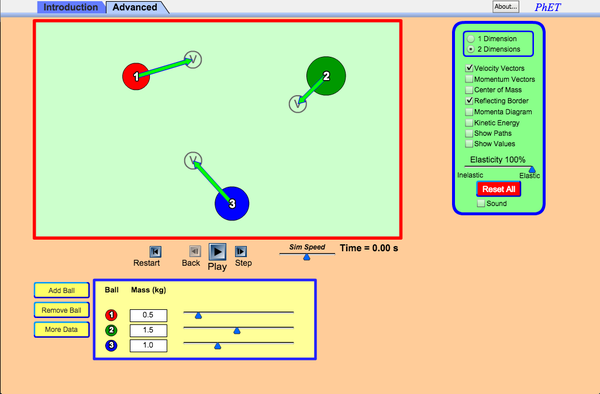Writing Homework Help
Writing Homework Help. 3.23 Conservation of Momentum Lab Module 3 – Newton’s Nook
Purpose: To explore conservation of momentum in a lab
setting
Introduction to the variables and equations:
Basic equation for momentum of a single object:

Subscripts o and f can be included in the equation to represent initial (before collision) and
final (after collision) values. Subscripts 1 and 2 can be included to represent mass 1 and mass 2.
Specific equations for initial and final momentum of mass 1 and mass 2:
Initial momentum
for mass 1: p1o =
m1v1o
Initial momentum for mass 2: p2o =
m2v2o
Final momentum for mass 1:
p1f =
m1v1f
Final momentum for mass 2:
p2f =
m2v2f
Initial momentum total and final momentum total can also be calculated by taking the sum of the momentum values
for each cart.
Total momentum equations:
Initial momentum total = m
1v1o + m2v2o
Final momentum total = m1v1f
+ m2v2f
Conservation of momentum occurs when the initial momentum total equals the final momentum total.
Conservation of momentum equation:

Procedure:
- Determine a hypothesis for the given collisions by answering the following question: Which collisions
will experience conservation of momentum? - Use the following simulation, Collision Lab, to complete this lab. Note: The simulation will open in a
new window and requires Java to run.

Select to Run © 2015 University of Colorado
- In the simulation, ensure that you are using the “Introduction” tab and for the table,
select “More Data” so that you can see the velocity of each mass. Also, move the slider
for “Sim Speed” so that it is all the way to the left. This makes the simulation slow enough to
see what happens. For the table on the right, you can choose to have “Velocity Vectors”
and “Show Values” boxes checked if you please. - You will use the table at the bottom of the simulation to input values of mass and initial velocity for
the two masses. For tables 1 through 6, you will record the velocity directly after the masses collide.
This will be the final velocity for each mass. Make sure that the two masses are at least 2 m apart by
changing their position values. Remember to hit the reset button to start the next collision. - In Collision 1 and Collision 2, ensure “Elasticity” is 100%
by moving the slider all the way to the right. This signifies an “Elastic” collision. Watch
the simulation closely and make note of what an elastic collisions looks like.
Record the final
velocity and complete the calculations for each trial. - In Collision 3 and Collision 4, change “Elasticity” to 0%
by moving the slider all the way to the left. This signifies an “Inelastic” collision. Again,
watch the simulations closely and make note of what an inelastic collision looks like.
Record the final
velocity and complete the calculations for each trial. - For Collision 5 and Collision 6, you are going to create your own data.
Choose your own masses and initial velocities for the two masses. You can choose a rear-end collision or a
head-on collision. One must be elastic and the other must be inelastic.
Record and complete the
calculations for each trial. - After completing collisions 1 through 6,
complete the last
table by calculating the initial momentum total and final momentum total for each collision. -
Input Values
Elastic Collision
between equal mass:Collision 1 Mass
(kg)Initial Velocity
(m/s)Final Velocity
(m/s)Momentum Initial
(kg*m/s)Momentum Final
(kg*m/s)Mass 1 2.0 + 50.0 Mass 2 2.0 – 50.0
Elastic Collision
between unequal mass:Collision 2 Mass
(kg)Initial Velocity
(m/s)Final Velocity
(m/s)Momentum Initial
(kg*m/s)Momentum Final
(kg*m/s)Mass 1 1.0 + 50.0 Mass 2 2.0 – 50.0
Inelastic Collision
between equal mass:Collision 3 Mass
(kg)Initial Velocity
(m/s)Final Velocity
(m/s)Momentum Initial
(kg*m/s)
Momentum Final
(kg*m/s)Mass 1 2.0 + 50.0 Mass 2 2.0 – 50.0
Inelastic Collision
between unequal mass:Collision 4 Mass
(kg)Initial Velocity
(m/s)Final Velocity
(m/s)Momentum Initial
(kg*m/s)Momentum Final
(kg*m/s)Mass 1 1.0 + 50.0 Mass 2 2.0 – 50.0
Your own Elastic Collision:
Collision 5 Mass
(kg)Initial Velocity
(m/s)Final Velocity
(m/s)Momentum Initial
(kg*m/s)Momentum Final
(kg*m/s)Mass 1 Mass 2
Your own Inelastic Collision:
Collision 6 Mass
(kg)Initial Velocity
(m/s)Final Velocity
(m/s)Momentum Initial
(kg*m/s)Momentum Final
(kg*m/s)Mass 1 Mass 2
Calculations:
Collision Total Momentum Initial
(kg*m/s)Total Momentum Final
(kg*m/s)Collision 1 Collision 2 Collision 3 Collision 4 Collision 5 Collision 6
Questions and Conclusion:
-
Based on your observations
of the six collisions, describe the physical difference
between elastic and inelastic collisions. -
How are you able to
determine if conservation of momentum occurs in each
collision? -
Write a complete conclusion
for this lab.
"Our Prices Start at $11.99. As Our First Client, Use Coupon Code GET15 to claim 15% Discount This Month!!"


